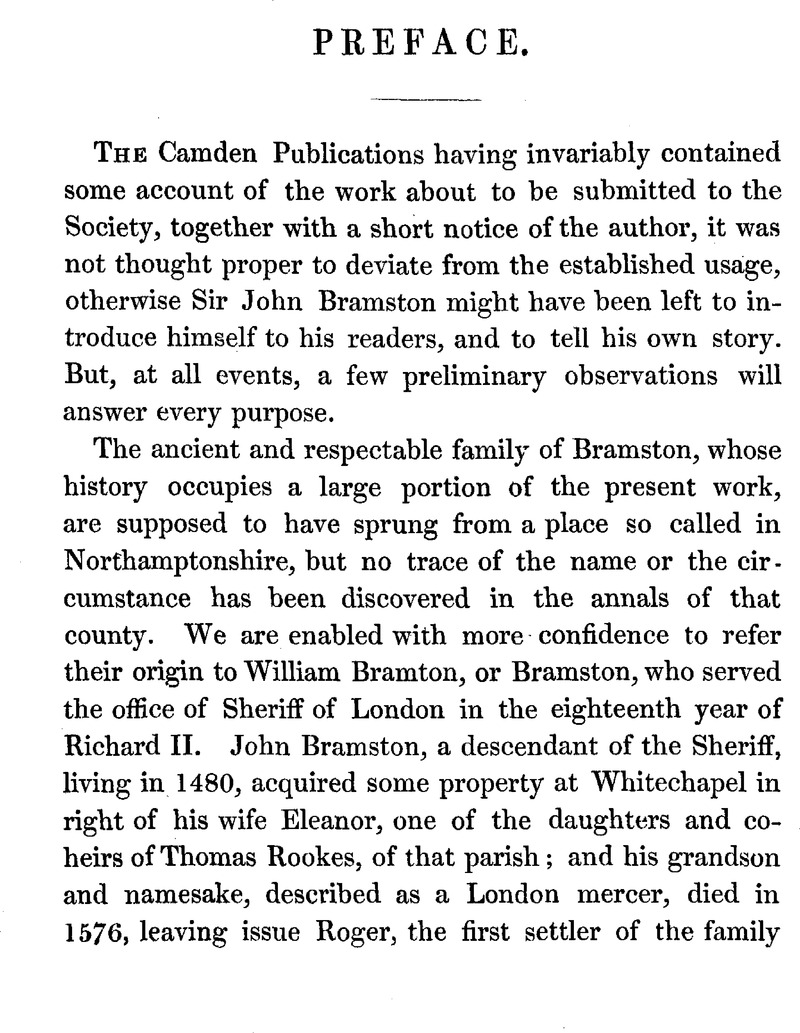Article contents
Abstract

- Type
- Preface
- Information
- Camden Old Series , Volume 32: The Autobiography of Sir John Bramston, K.B., of Skreens, in the Hundred of Chelmsford , June 1845 , pp. v - xvi
- Copyright
- Copyright © Royal Historical Society 1845
References
page vi note * The mansion house took its name from William Skrene, of Writtle, constituted Serjeant-at-Law 10th Henry IV. It passed afterwards to the Farmers, and Sampfords, by one of whom, Richard Sampford, it was alienated to Richard Weston, who became a Justice of the Common Pleas, and whose son, of the same name, afterwards Lord High Treasurer, was created Earl of Portland in 1632–3.
“The manor of Skreens” (observes Morant, History of Essex, vol. ii. p. 73) “has been all along in families that have raised themselves by their merit and eminence in the law, a circumstance attaching to no other estate that we know of in this county.” There can be no question that Chief Justice Bramston, who purchased the estate from the Westons, as well as his two brothers, one of whom was a Judge and the other a Master in Chancery, kept up the charter; but it is only right to state that at a much later period Thomas Gardiner Bramston, Esq., the last possessor of Skreens, so endeared himself to his brother magistrates as a Justice of the Peace and Chairman of the Quarter Sessions, and by his unwearied attention to the interests of the county, that after his lamented death they caused his Bust, executed in marble by Ternouth, to be placed in the Grand Jury Room at Chelmsford, with the following inscription :—
THIS TABLET IS ERECTED
BY THE MAGISTRATES OF ESSEX, TO THE MEMORY
OF THOMAS GARDINER BRAMSTON, ESQUIRE, OF SKREENS,
WHO DURING TWENTY YEARS
PRESIDED AS ONE OF THE CHAIRMEN OF THEIR QUARTER SESSIONS,
AND IN THAT AND EVERY OFFICE
CONNECTED WITH THE GENERAL INTERESTS OF THE COUNTY
EVINCED SO CLEAR A JUDGMENT,
DISPOSITION SO CANDID AND CONCILIATING,
SO UNWEARIED A PERSEVERANCE
INVESTIGATING THE CLAIMS OF TRUTH AND JUSTICE,
AND SUCH INTEGRITY OF PURPOSE IN MAINTAINING THEM,
AS INSURED TO HIM THE CONFIDENCE
OF THOSE WITH WHOM HE SHARED HIS PUBLIC DUTIES,
AND AFFORDED A BRIGHT EXAMPLE OF A CHARACTER
GUIDED BY THE PRINCIPLES OF A TRULY CHRISTIAN MIND.
HE DIED THE 3D OF FEBRUARY, 1831,
THE 61ST YEAR OF HIS AGE.
page viii note * Memoir, page 103.
page ix note * Memoir, page 103.
page xi note * The volume does contain the Reading alluded to, described as “Lectura Francisci Bramston Armigeri in Medio Templo, tertio Augusti 1668, super Statut. de tertio Jacobi, Cap. 4 ; entitled, An Act for the discovering and repressinge of Popish Recusants.” The Autobiographer only means that he wrote in the blank leaves of a book originally prepared for another purpose.
“Mr. Bramston, my old fellow-traveller (in Italy), now Reader at the Middle Temple, invited me to his feast, which was so very extravagant and greate as the like had not been seene at any time. There were the Duke of Ormond, Privy Seal, Bedford, Belasys, Halifax, and a world more of Earls and Lords.”—Evelyn's Diary, August 3, 1668.
page xi note † Amongst the monuments in the parish church, says Watson, the historian of Wisbech, that of Thomas de Braunstone is the most ancient. He was Constable of the Castle there, and, dying in 1401, was interred in the south aisle, where is a gravestone with his effigy engraved on brass plates. He is represented, under a rich Gothic canopy, in plate armour and painted helmet, with a lion at his feet, and this inscription round the verge of the stone:—
“Cy gist Thomas de Braunstone, jadis Conestable du Chatel de Wisebeche, qui mourut le vingt septieme jour de Maii, l' an de notre Seignour Mil CCCC primer. De l' alme de qui Dieu par sa grace ait mercy. Amen.”
There seems also to have been another monument of Bramstone of Wisbech in the church of Boston or Walpole; but nothing certain is known as to their being the ancestors of the Skreens family.—History of Wisbech, p. 259.
page xii note * Memoir, page 3.
page xiv note * Memoir, page 158.
- 1
- Cited by




